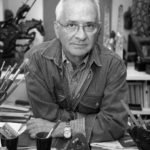Feito, Luis

Luis Feito was born in Madrid in 1929. He was one of the founders of the group \"El Paso\" and today he is considered one of the most important contemporary spanish artists of the 20th and 21st centuries.
He started his artistic career in 1950, when he entered the Real Academia de Bellas Artes de San Fernando in Madrid. In the early stages of his career, he explored both figurative and cubist styles until 1953, when he fully embraced abstraction as his primary artistic focus.
In 1954 Luis Feito presented for the first time his new abstract works at Galería Buchholz and Galería Fernando Fe, two renown modern galleries in Madrid. A year later he held his first exhibition in Paris at Galeria Arnaud, where he would go onto showcasing his work for the next 25 years. In the same year he obtained a scholarship from the French Government and moved to Paris. It was during this period that he was influenced by automatism and, especially, by materic painting, which led him to work with oil paste and sand, as well as adopt a more white, black and ochre palette.
After living in Paris for a while, Feito found that the spanish art scene was not sufficiently progressive. Consequently, he created together with other artists and art critics, the group \"El Paso\". This was one of the first avant-garde movements in the post-war era in Spain, introducing the concepts of informalism and abstract expressionism.
Following his impressive solo showcases at the Venice Biennale of 1958 and 1960, along with his collective exhibitions with \"El Paso\", Feito began to have a significant international presence.
Around 1962, Feito introduced the color red into his paintings, applying it in circular structures and motifs. Since 1963 his artworks tended towards a formal and material simplification. However, in the 70s strong colors and geometric shapes took over, culminating a decade filled with white squares. In 1981 he left Paris and moved to Montreal until 1983, when he established his residence in New York until the early 90s.